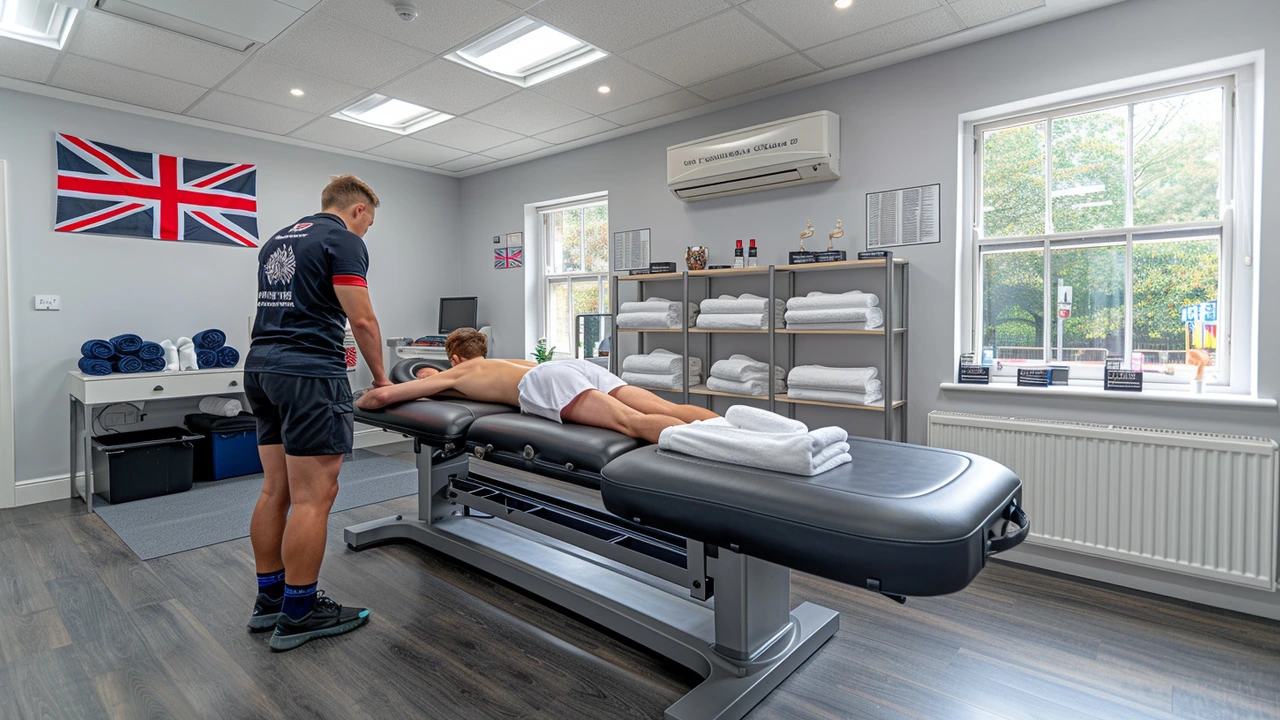For athletes, maintaining peak physical condition is crucial, and sports massage is a powerful tool in their wellness arsenal. This massage technique is specifically tailored to support the physical demands athletes face, helping to boost performance, aid in muscle recovery, and prevent injuries.
Understanding the benefits and techniques of sports massage can offer athletes an edge in their training and recovery, ensuring they stay in top form while minimizing the risk of injury. Whether you're a professional or a weekend warrior, incorporating sports massage into your regimen can make a significant difference in your overall wellness.
- Benefits of Sports Massage
- Techniques and Methods
- Prevention and Recovery
- Incorporating Massage into Daily Regimen
Benefits of Sports Massage
Sports massage is not just about relaxation; it has numerous concrete benefits that make it an essential part of an athlete's wellness routine. One of the key advantages is enhanced muscle recovery. Post-exercise, muscles can endure tiny tears and inflammation. A good sports massage alleviates this soreness by improving blood circulation, which helps to bring more nutrients to the damaged tissues and accelerates the healing process.
Another significant benefit is reduced risk of injuries. Tight or overworked muscles are prone to strains, tears, and other injuries. Regular sports massages contribute to muscle flexibility and greater range of motion, making athletes less susceptible to injuries. It's like maintaining your car; regular care keeps it running smoothly.

Techniques and Methods
When it comes to sports massage, various techniques and methods are employed to address the specific needs of athletes. Each technique targets different muscle groups and performs unique functions, helping with muscle recovery, reducing tension, and improving flexibility. Understanding these techniques can provide insights into how they can be effectively incorporated into regular athletic training regimes.
One of the primary techniques used in sports massage is effleurage. This involves long, gliding strokes that are usually performed with the palms, fingers, or thumbs. Effleurage helps warm up the muscle tissue and increase blood circulation, which is essential for muscle recovery and preventing stiffness. It also helps in calming the nervous system, preparing the muscles for more intensive massage techniques.
Petrissage is another popular method, characterized by kneading, rolling, and squeezing movements. This technique targets deeper layers of muscle tissue and is beneficial for breaking down muscle knots and adhesions. Petrissage helps improve the elasticity of muscle fibers and can alleviate chronic muscle tension that athletes often experience due to repetitive movements and strenuous training sessions.
Trigger point therapy is frequently used in sports massage to address specific areas of muscle tightness or knots, known as trigger points. These points can cause pain or discomfort in other parts of the body, known as referred pain. Applying direct pressure to these points can release the tension and alleviate pain. This technique requires precision and a good understanding of the muscle anatomy to be effective.
Sports massage also involves techniques such as friction and tapotement. Friction involves deep circular movements using fingers or thumbs to penetrate deep muscle layers and break down scar tissue. Tapotement includes rhythmic tapping or pounding of the muscles with hands or fingers, which helps in stimulating muscle fibers and reviving them from fatigue. These techniques are essential for athletes who need to recover quickly and maintain muscle integrity.
Athletes can benefit from incorporating stretching into their sports massage routine. This often includes both static and dynamic stretches. Stretching helps in promoting flexibility, reducing muscle tension, and improving the range of motion. A well-stretched muscle is less prone to injuries, ensuring athletes can perform at their best without the risk of strains or sprains.
According to the American Massage Therapy Association, "Regular sports massage can significantly enhance athletic performance and prolong the athlete's career by maintaining muscle flexibility and reducing the risk of injuries."
Another essential method is the use of myofascial release, a technique that focuses on relieving tension in the fascia, the connective tissue surrounding muscles. This technique involves applying sustained pressure to the fascia, helping in releasing chronic tension and improving blood flow. Myofascial release is particularly beneficial for athletes who experience tightness or restrictions in certain body areas that can impact their performance.
Lastly, active release techniques (ART) are used to treat and prevent soft tissue injuries. ART involves identifying, isolating, and targeting the affected area, combining precise movements with deep tissue manipulation. This helps in breaking up adhesions, restoring mobility, and reducing muscle pain. Athletes undergoing ART can expect improved flexibility and quicker recovery times.

Prevention and Recovery
Sports massage excels in both preventing injuries and promoting recovery, two critical aspects for athletes of all levels. Athletes put their bodies under tremendous stress, which often results in muscle tensions, small tears, and other injuries. Regular sports massages can help in identifying these minor issues before they adversely affect performance or develop into more severe injuries.
A critical way sports massage aids in prevention is by improving tissue permeability. This means that essential nutrients can better reach muscle tissues while waste products, such as lactic acid, are efficiently removed. This process helps reduce muscle soreness and accelerates recovery time, keeping athletes fresh and able to train consistently.
An example of sports massage effectiveness is seen in studies highlighting its effect on DOMS (Delayed Onset Muscle Soreness). Notable research reveals that athletes who incorporated sports massage into their routine experienced significantly less severe symptoms of DOMS. This finding underscores the importance of regular massage in preventing prolonged soreness post-intense exercises.
In terms of recovery, sports massage is particularly effective in reducing inflammation and swelling around joints caused by intense physical activities. It helps maintain or improve flexibility, which can be particularly beneficial during peak competition periods. Enhancing blood circulation through massage promotes faster healing of injured tissues, meaning that athletes can return to their sport quicker than relying on passive rest alone.
Quote from a trusted source on the importance of sports massage can be helpful in understanding the depth of its benefits:
“Sports massage is an invaluable tool in both an athlete's recovery and prevention toolkit. It keeps the body functioning at peak efficiency.” - Dr. Sarah Jacobs, Sports Medicine Specialist
| Benefit | Impact |
|---|---|
| Improved Blood Flow | Aids in nutrient delivery and waste removal |
| Reduced Muscle Tension | Lowers risk of injuries |
| Enhanced Flexibility | Prevents strain and promotes better workouts |
Sports massage not only addresses physical ailments but also supports mental recovery. The relaxation effect of a massage can reduce anxiety and stress, leading to improved sleep and mental clarity. For athletes, getting enough rest is paramount to maintaining high performance levels.
Regular sports massages can also teach athletes to be more in tune with their bodies. This heightened bodily awareness helps in the early identification of potential issue areas, allowing for timely intervention before these concerns escalate into full-blown injuries.

Incorporating Massage into Daily Regimen
When it comes to athletic performance, consistency and recovery are key pillars. Integrating sports massage into your daily regimen can have a profound impact on your physical and mental well-being. Starting with a morning routine, consider incorporating a brief self-massage session. Using tools like foam rollers or massage balls, athletes can target key muscle groups such as the calves, hamstrings, and shoulders.
Self-massage in the morning helps to wake up the muscles, increase blood flow, and prepare the body for the physical demands of the day. Additionally, these sessions can serve as an important moment of mindfulness, allowing athletes to mentally prepare for their upcoming activities and set a positive tone for the day.
On training days, incorporating a professional sports massage post-workout can significantly enhance recovery. These sessions typically focus on reducing muscle tension, eliminating waste products like lactic acid, and promoting relaxation. As noted by renowned sports therapist Steve Smith,
"Regular sports massage not only addresses muscle pain but also makes athletes more aware of their body, helping them avoid injuries."By scheduling massages after intense workouts, athletes can ensure they are taking the necessary steps to facilitate recovery and maintain peak performance.
For those with tight schedules, incorporating massage into the evening routine can be just as beneficial. At the end of the day, a short self-massage using essential oils or specialized lotions can help to relax the muscles and prepare the body for restful sleep. Lavender oil, for example, is known for its relaxing properties and can be especially beneficial when used in evening massages.
One effective method to ensure regular massages are part of your regimen is to create a weekly schedule. Allocate specific time slots for professional massages, self-massage sessions, and other recovery activities like stretching or yoga. This level of organization not only helps to ensure consistency but also allows athletes to monitor their progress and adapt their routines based on their needs and responses.
Another useful tip is to stay hydrated both before and after massages. Adequate hydration helps to flush out toxins released during the massage and keep the muscles supple and responsive. Drinking enough water is a simple yet critical aspect of maintaining muscle health and enhancing the overall benefits of sports massage.
Finally, always listen to your body. While incorporating regular massages is beneficial, it's essential to know when to take a break. If you experience any pain or discomfort that persists after a massage, consult with a healthcare professional to ensure that there are no underlying issues. Remember, the goal of sports massage is to support and enhance your athletic journey, not to cause harm.
By making massage a regular part of your routine, you can enjoy improved muscle function, reduced injury risk, and better overall athletic performance. With careful planning and mindful practice, the benefits of sports massage can be a lasting and integral part of your wellness strategy.
